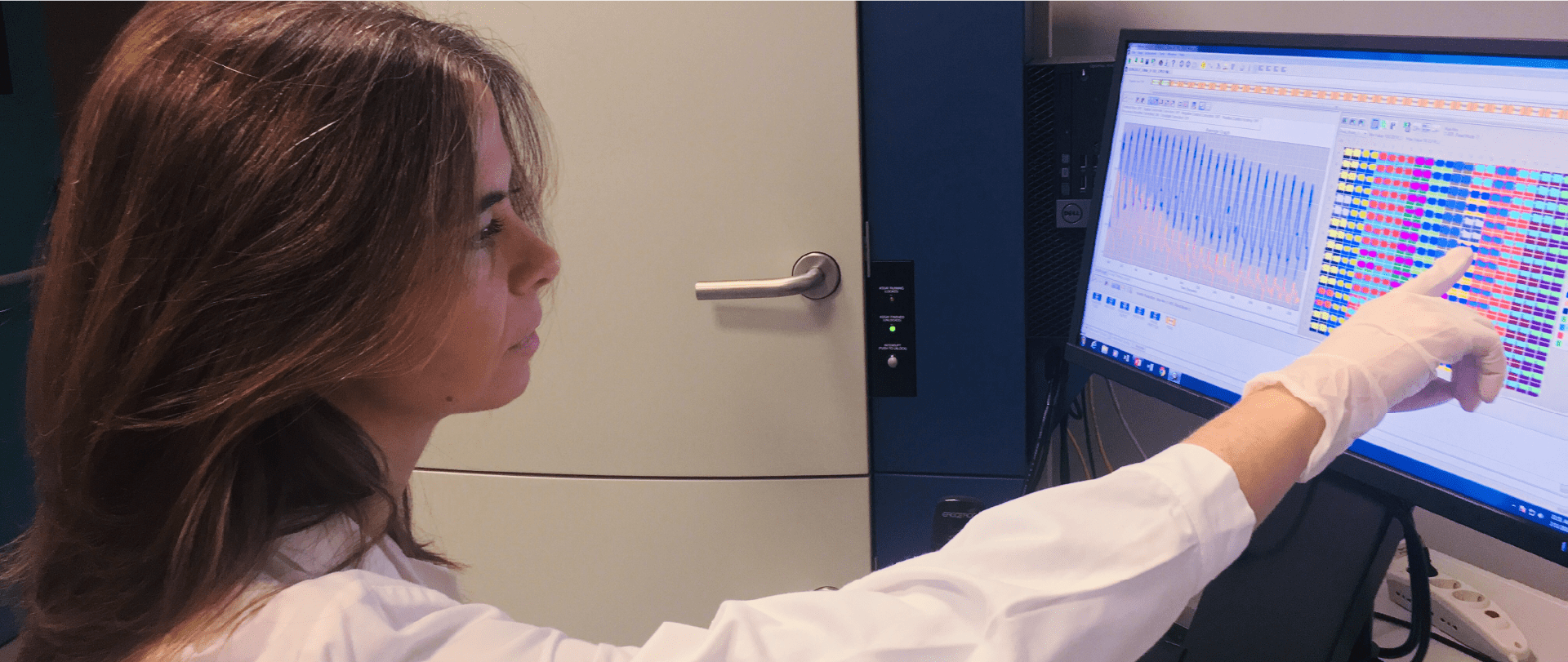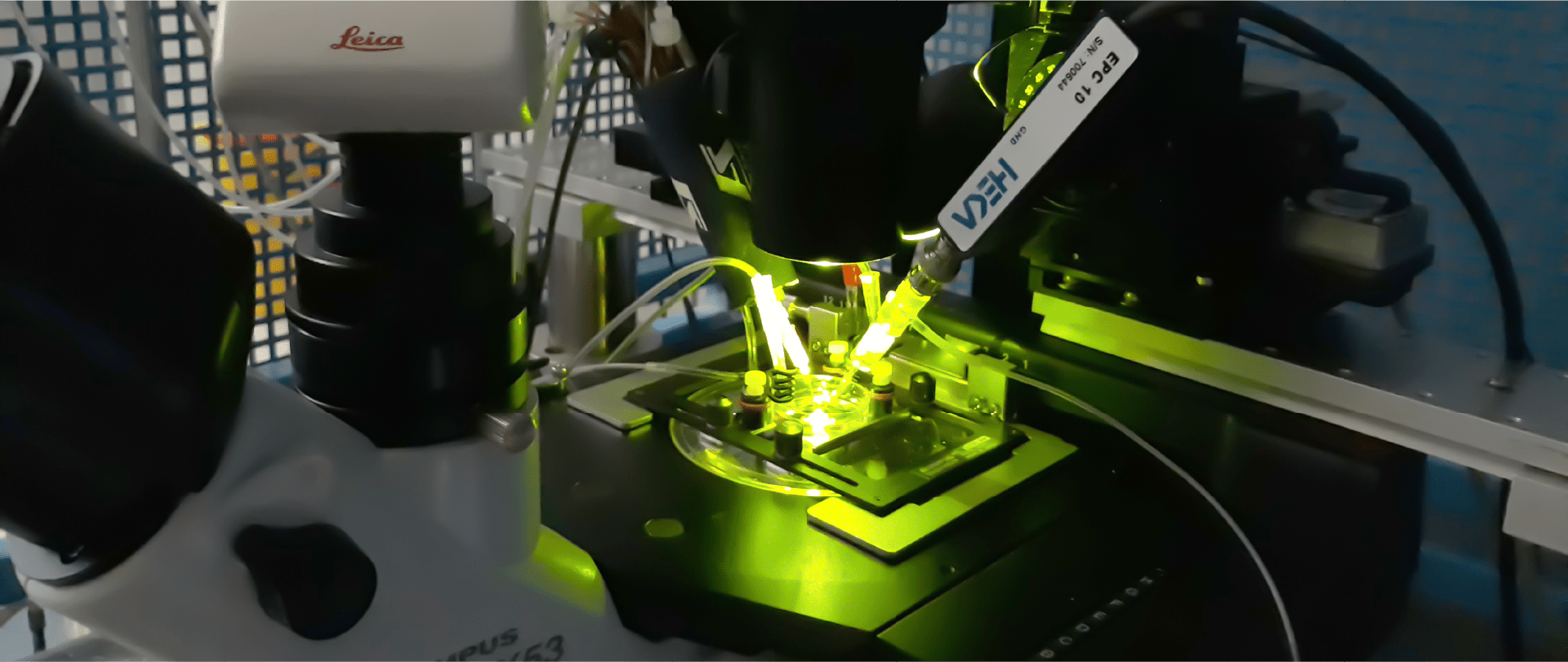Optogenetics applied to HTS
At Axxam, we have applied all the advantages of optogenetic technologies to the early phases of drug discovery, in order to build
High-Throughput Screening (HTS) assays with significant improvements in content, precision and biological relevance.
We have developed cellular assays using either light actuators or light sensors to study several drug targets:
- Light-gated Channelrhodopsin-2 was used to modulate NCX1 sodium-calcium exchanger as well as CaV1.2, CaV1.3 or CaV3.3 calcium channels and to identify state-dependent blockers; very recently, voltage-activated sodium channels were also paced by ChR2, obtaining highly improved sensitivity towards NaV channel modulators and blockers
- HCN1 and HCN2 channels were activated either by light activated bPAC adenylyl cyclase or by light hyperpolarizing tools
- Genetically encoded indicators for voltage or calcium were used for single- or multi-color detection of KIR2.3, TMEM16A, NaV1.5, CaV1.2, CaV3.3, ASIC, TRPM2 and muscarinic receptor activity; moreover, new dynamic and sensitive cAMP sensors were used for Gs and Gi-coupled GPCR assays
All these assays were fully miniaturized in a 384-well format and completely HTS adapted using the FLIPR Tetra (Molecular
Devices) or FDSS 7000 EX (Hamamatsu) instrumentation, providing innovative drug screening tools of improved biological
significance and effective operational costs and timelines.
Axxam also supports the clinical development of optogenetic gene therapies, through standardized pharmacological validation
tests required by the international guidelines for pharmaceuticals.
Have a look to our case studies:
ChR2, bPAC, ArcLight
CaV1.3 screening
ChR2 and NCX1
Opto gene therapy drug
FLIOP - Fluorescence Imaging and Optical Pacing
Our researchers and engineers have also developed FLIOP – “Fluorescence Imaging and Optical Pacing” (patent pending), a
system that provides the FLIPR Tetra® instrument with a programmable, millisecond-switched optogenetic pacing, enabling for
the first time simultaneous 384-well optical pacing, fluorescence imaging and compound addition.
FLIOP allowed to synchronize and repeatedly activate diverse cellular processes: voltage-gated calcium channels, voltage-gated
sodium channels and cardiac action potential of iPS-derived cells were synchronously stimulated by light-gated
Channelrhodopsin-2 at different repetitions and frequencies, enabling the study of blockers effect and use-dependency under
normal or pathological firing conditions.
With FLIOP, High-Throughput Screening campaigns and Hit-to-Lead activities can be run with the enriched biological relevance
of electrophysiology-like investigations while maintaining efficient operational costs and timelines. From the beginning of the
drug discovery program, FLIOP can deliver high quality hits, avoiding the selection of un-relevant and false active compounds
often resulting from the use of un-reversible and un-physiological chemical stimuli.

Optogenetics in Electrophysiology
In addition, to complete the characterization of cell lines expressing optically controlled ion channels, we have also setup an
“Opto manual patch-clamp platform”. The system integrates a broad-spectrum LED illumination device that allows to deliver light
pulses of programmable intensity, duration and wavelength while performing voltage- or current-clamp experiments.
With this setup, we successfully check the purity of in-house engineered clones stably expressing light-gated channel (for
instance: Channelrhodopsin-2) alone or together with voltage-, ligand-gated ion channels (for instance: NaV1.5).
This activity is mandatory not only to confirm the results obtained with the FLIPR Tetra® functional flux assay but also to
establish a strong correlation between these techniques used along the drug discovery cascade.

How can we support your research programs?
We offer construction of optogenetic cell lines (both with light actuators and light sensors), which can be transferred to our
clients or run as part of contract research studies at Axxam, including HTS campaigns with clients’ and/or Axxam compound collections.
Do you need more information on optogenetics?
To learn how optogenetics has revolutionized the drug screening world, read the following articles:
V. Agus et al., SLAS Discov (2021)
V. Agus et al., SLAS Discov (2018)
H. Zhang et al., Trends Biotechnol (2017)
V. Agus et al., Curr Opin Biotechnol (2017)
